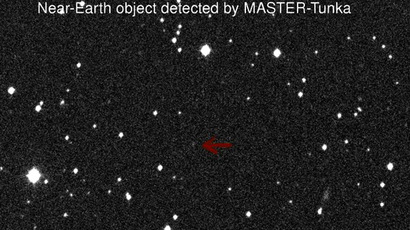410-meter asteroid ‘may collide’ with Earth in 2032

A potentially catastrophic asteroid has been discovered by astronomers, who say there’s a slim chance that the 410-meter-wide minor planet will crash into Earth in 2032, creating a blast 50 times greater than the biggest nuclear bomb.
The asteroid, described as 2013 TV135, was found in the
Camelopardalis (Giraffe) constellation by the Crimean
Astrophysical Observatory in southern Ukraine, the Minor Planet
Center of the International Astronomers Union said.
“On the night of October 12, I was watching the Giraffe
constellation, it was an in-depth monitoring as part of the comet
search program,” Gennady Borisov from the Crimean
Astrophysical Observatory told Itar-Tass news agency. “This is
when the asteroid… was discovered. The first observations show
that it moves quickly and is relatively close.”
The discovery has been confirmed by astronomers in Italy, Spain,
the UK and Russia. In Russia, it was seen with telescopes at the
Master Observatory in the Siberian republic of Buryatia, the IAU
Minor Planet Center said.

The asteroid has been added to the List of the Potentially
Hazardous Asteroids, which includes celestial bodies with orbits
closer than 7.5 million kilometers from the Earth’s orbit.
However, the threat posed by the 2013 TV135 is minor. Updated
estimates show that it has a one in 14,000 chance of colliding
with our planet, which is five times as probable as the initial
estimate of 1 in 63,000, but still negligible.
Astronomers say the asteroid’s orbit will be about 1.7 million
kilometers away from the Earth’s orbit on August 26, 2032.
If the asteroid hits Earth, it would create an explosion
equivalent to 2,500 megatons of TNT, which is 50 times greater
than the biggest nuclear bomb ever detonated.

Scientists will be able to better evaluate the impact risk of
2013 TV135, and even determine its possible impact site on Earth
by 2028, Timur Kryachko from the Crimean Astrophysical
Observatory told the RIA Novosti news agency.
The discovery was mentioned by Russian Deputy Prime Minister
Dmitry Rogozin, who is pushing for the development of
anti-asteroid defense systems.
“Here’s a super-task for our space industry,” Rogozin said of
the asteroid on his Twitter page.
The 2013 TV135 has been given a 1 out of 10 rating on the Torino
Scale, used to estimate asteroid impact hazards, which means it
“poses no unusual level of danger” and “the chance of
collision is extremely unlikely.”
According to NASA’s Near Earth Object Program, there is currently
just one asteroid that has the same rating. It’s called 2007
VK184. At 130 meters wide, it has 1 in 1,820 chance of impacting
Earth on June 3, 2048.
The chances that any other near-Earth asteroid will crash into
earth in the next 100 years is estimated at “effectively
zero” by NASA.














